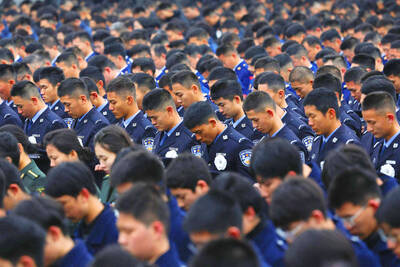Lion bones have become a hot commodity for their use in Asian traditional medicine, driving up exports from South Africa to the East and creating new fears of the survival of the species.
Conservationists are already angry over lion trophy hunting.
The skeletons are mostly shipped to Vietnam and Laos, feeding conservationists’ fears that the market will drive up lion poaching — just as the illegal hunting of rhinos escalates for their horns, also popular in Asian traditional remedies.
“Suddenly, and very recently, there are a great number of people from Laos who have a big interest for trophy hunting. And that had never happened in the whole history of Laos” said Pieter Kat from conservation NGO LionAid.
Around 500 lions are hunted legally every year in South Africa, most of them from commercial lion breeding farms which also supply zoos all over the world.
Until recently, hunters paid US$20,000 for a trophy to hang above the fireplace and the carcass was thrown to the dogs.
However, their crushed bones have become popular as substitute for the bones of tigers in love potions or “tiger wine.” Trade in tiger parts is banned under international law as the animal is a threatened species.
Now Asian hunters buy lion trophy hunting permits to get at the bones.
“They prefer hunting lionesses, whose US$4,000 price tag is more affordable than the males,” Kat told reporters.
Most swear it is about the trophy, which means safari operators and breeders can easily dispose of the carcass at the same time and make an extra profit.
A lion skeleton these days fetches up to US$10,000.
A few hundred partial or complete lion skeletons were shipped out of the country in 2010, according to latest official figures — all completely legal.
“That trade is monitored very, very closely by provincial officers,” chairman of the South African Predator Breeders Association Pieter Potgieter said. “They don’t release the bones unless they are sure that they come from a legally hunted lion or that the lion died of natural causes.”
However, activists cry foul play, saying it is worsening the captive breeding of lions for what has come to be known as “canned” hunting.
“Lions are now being specifically bred in captivity to be ‘harvested’ for their bones,” said Paul Hart, who runs a lion sanctuary in the south west of the country.
Animal rights groups also say some cats are killed off on the sly, a theory possibly supported by the nabbing of illegal exporters at OR Tambo International Airport in Johannesburg.
Breeders are also coy about the number of lions they have on their farms. South Africa is thought to have 5,000 in captivity.
Yet the bones of wild lions — thought to be more potent — are worth even more in Asia, which threatens the 3,000 big cats left in the country’s reserves, animal rights groups say.
Around 700,000 people signed an online petition asking South African President Jacob Zuma to suspend lion bone exports from his country.
“It is just a question of time before the poachers find their way in this market and kill the lions. Why should they go and buy an expensive carcass from a breeder if they can poach it and get it for nearly nothing?” said Chris Mercer from the Campaign Against Canned Hunting.
Breeders deny the lion bone trade will spark poaching similar to that of rhinos. Almost 500 rhinos were killed last year alone for their horns, whose trade is banned.
“If lion bone is available legally, on the market, why would anyone choose to take all the risks and costs associated with poaching? The South African lion breeding industry can supply a lot of demand and we can make a contribution towards the saving of the Asian tigers and also the South African lions,” Potgieter said.
Groups are divided over the dilemma: maintain a regulated trade in lion carcasses from captive animals or outlaw the trade and risk a spike in poaching. Authorities, meanwhile, have remained silent.

PARLIAMENT CHAOS: Police forcibly removed Brazilian Deputy Glauber Braga after he called the legislation part of a ‘coup offensive’ and occupied the speaker’s chair Brazil’s lower house of Congress early yesterday approved a bill that could slash former Brazilian president Jair Bolsonaro’s prison sentence for plotting a coup, after efforts by a lawmaker to disrupt the proceedings sparked chaos in parliament. Bolsonaro has been serving a 27-year term since last month after his conviction for a scheme to stop Brazilian President Luiz Inacio Lula da Silva from taking office after the 2022 election. Lawmakers had been discussing a bill that would significantly reduce sentences for several crimes, including attempting a coup d’etat — opening up the prospect that Bolsonaro, 70, could have his sentence cut to

China yesterday held a low-key memorial ceremony for the 1937 Nanjing Massacre, with Chinese President Xi Jinping (習近平) not attending, despite a diplomatic crisis between Beijing and Tokyo over Taiwan. Beijing has raged at Tokyo since Japanese Prime Minister Sanae Takaichi last month said that a hypothetical Chinese attack on Taiwan could trigger a military response from Japan. China and Japan have long sparred over their painful history. China consistently reminds its people of the 1937 Nanjing Massacre, in which it says Japanese troops killed 300,000 people in what was then its capital. A post-World War II Allied tribunal put the death toll

‘UNWAVERING ALLIANCE’: The US Department of State said that China’s actions during military drills with Russia were not conducive to regional peace and stability The US on Tuesday criticized China over alleged radar deployments against Japanese military aircraft during a training exercise last week, while Tokyo and Seoul yesterday scrambled jets after Chinese and Russian military aircraft conducted joint patrols near the two countries. The incidents came after Japanese Prime Minister Sanae Takaichi triggered a dispute with Beijing last month with her remarks on how Tokyo might react to a hypothetical Chinese attack on Taiwan. “China’s actions are not conducive to regional peace and stability,” a US Department of State spokesperson said late on Tuesday, referring to the radar incident. “The US-Japan alliance is stronger and more

FALLEN: The nine soldiers who were killed while carrying out combat and engineering tasks in Russia were given the title of Hero of the Democratic People’s Republic of Korea North Korean leader Kim Jong-un attended a welcoming ceremony for an army engineering unit that had returned home after carrying out duties in Russia, North Korean state media KCNA reported on Saturday. In a speech carried by KCNA, Kim praised officers and soldiers of the 528th Regiment of Engineers of the Korean People’s Army (KPA) for “heroic” conduct and “mass heroism” in fulfilling orders issued by the ruling Workers’ Party of Korea during a 120-day overseas deployment. Video footage released by North Korea showed uniformed soldiers disembarking from an aircraft, Kim hugging a soldier seated in a wheelchair, and soldiers and officials